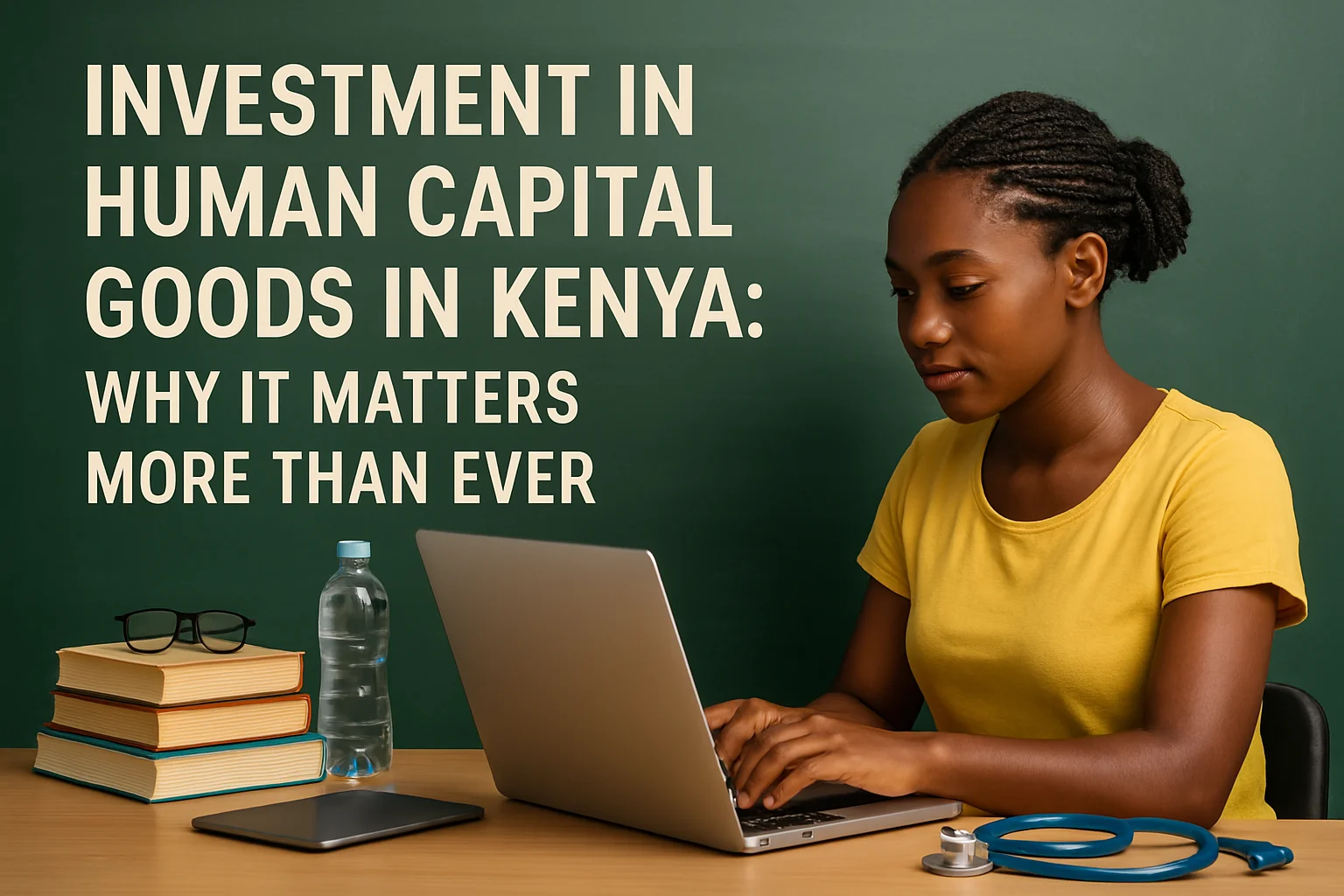Walk into any youth innovation hub in Nairobi or a teacher training center in Kisumu, and you’ll notice one thing: Kenya is betting big on people. Behind every software engineer, trained healthcare worker, or vocational student is something deeper at play — investment in human capital goods in Kenya. But what does that really mean?
This isn’t about buildings or machines. It’s about the books, training, health access, and digital tools that build the mind and body. It’s the heartbeat of sustainable growth. And if Kenya wants to future-proof its economy, investing in people — not just infrastructure — is non-negotiable.
What Does “Investment in Human Capital Goods in Kenya” Actually Mean?
Before we dive into stats or strategies, let’s cut the jargon. Investment in human capital goods in Kenya refers to allocating money, time, and resources into tools that improve human ability. These “goods” include:
- Quality education materials
- Health and nutrition programs
- Digital learning platforms
- Vocational and professional training
- Public health infrastructure like clinics and clean water access
Unlike physical capital (roads, factories), human capital is stored in people. And when done right, it pays off for generations.
Why Kenya’s Future Depends on This Investment
It’s no secret: Kenya’s youth population is booming. Over 70% of Kenyans are under 35. But potential alone doesn’t spark growth — prepared people do.
Here’s the thing: countries with comparable GDPs that invested early in human capital — like Vietnam or Bangladesh — have outpaced peers by building skilled, healthy, resilient populations. Kenya’s challenge? Catch up, and do it fast.
When investment in human capital goods in Kenya scales correctly, here’s what follows:
- Increased school completion rates
- Decrease in preventable diseases
- Higher labor productivity
- Innovation in tech, agriculture, and services
- Inclusive urban-rural development
Education: The Cornerstone of Human Capital in Kenya
Let’s talk about classrooms — both physical and digital. Kenya has made strides with free primary education, but quality is still uneven.
Key initiatives boosting education as a human capital good:
- Digital Literacy Programme (DLP): Government-issued tablets in primary schools aim to prepare students for a digital economy.
- TVET expansion: Technical and Vocational Education and Training institutions are receiving major upgrades.
Still, access doesn’t equal impact. Without quality materials, trained teachers, and follow-through, investment in human capital goods in Kenya risks being a paper promise.
Pro Tip: Countries that link TVET skills to market demand — like Germany or South Korea — see higher youth employment. Kenya’s path? Bridge academia and industry more directly.
Health and Nutrition: A Silent Driver of Economic Output
You can’t educate or train a population that’s unhealthy. It’s that simple.
Investment in human capital goods in Kenya is incomplete without public health. Maternal care, child vaccinations, nutrition programs — these aren’t side issues. They’re foundation stones.
- Malnourished children underperform cognitively.
- Unhealthy workers reduce GDP by up to 15%.
- Poor mental health limits productivity across all sectors.
Programs like Linda Mama (free maternity services) and county-level nutrition support are helping. But funding gaps, staffing shortages, and infrastructure inequities still haunt rural Kenya.
Technology as a Force Multiplier in Human Capital Development
One standout aspect of investment in human capital goods in Kenya is how digital tech plays a dual role — both as a capital good and as a delivery system.
Examples worth noting:
- E-learning platforms like Eneza Education reach learners via SMS — no smartphone needed.
- mHealth tools connect rural clinics with remote doctors.
- Apps like M-Shule customize learning paths using AI and SMS in underserved schools.
If used right, technology can eliminate the urban-rural divide in human capital development. But beware of the hype: tech only works if paired with proper training, maintenance, and policy support.
Challenges Slowing Human Capital Investment in Kenya
Despite the promise, investment in human capital goods in Kenya faces serious roadblocks:
- Budgetary constraints in health and education
- Brain drain – Skilled workers seek better pay abroad
- Unequal regional development
- Underinvestment in early childhood development
These aren’t minor issues. They threaten long-term returns on investment and deepen inequality if left unaddressed.
Policy Takeaway: Shift from input-focused budgeting (number of classrooms built) to outcome-focused impact (number of students skilled and employed).
Practical Guide: How Can Stakeholders Support This Investment?
Whether you’re a policymaker, donor, or entrepreneur, here are real actions to support investment in human capital goods in Kenya:
1. Align Education with Market Demand
- Encourage industry-led curriculum development in TVETs.
- Fund public-private apprenticeship programs.
2. Strengthen Data Systems
- Track health, school, and training outcomes to adjust strategy in real time.
- Use mobile data collection to close rural reporting gaps.
3. Incentivize Rural Retention
- Offer tax breaks or housing to teachers, doctors, and skilled trainers in underserved areas.
4. Invest in Early Childhood Development
- Prioritize funding for nutrition, preschool, and parental support programs.
Tools and Programs Driving Change in Kenya
Let’s name names. These tools and programs are reshaping human capital outcomes:
- Elimu Yetu Coalition – advocacy for quality, inclusive education
- Afya Elimu Fund – low-interest loans for healthcare students
- Uwezo Fund – supports youth and women entrepreneurship
- Ajira Digital Program – trains youth in online freelance skills
Understanding and supporting these tools means accelerating Kenya’s growth — not in 20 years, but now.
Long-Term Outlook: What Happens If Kenya Gets This Right?
If investment in human capital goods in Kenya becomes a political, economic, and social priority, the results will be transformational:
- Lower unemployment, especially among youth
- A skilled workforce that attracts global companies
- Better healthcare outcomes and longer life expectancy
- Increased innovation and startup growth
- A truly inclusive middle class
But the clock is ticking. Every year of delayed investment equals billions in lost potential.
FAQs
- What is meant by investment in human capital goods in Kenya?
It refers to investing in tools like education, training, and health systems that improve people’s skills, knowledge, and well-being, which ultimately drive national development. - How does Kenya compare with other African countries in human capital investment?
Kenya leads in tech-driven education and health innovation, but still lags in early childhood investment and rural health infrastructure compared to countries like Rwanda. - Why is vocational training important in this context?
Vocational training links education to real-world employment. Kenya’s investment in TVETs is helping close the skill mismatch gap — essential for job creation. - Is digital education effective in rural Kenya?
Yes, tools like Eneza and M-Shule are making quality learning accessible even without internet or smartphones. However, success depends on local teacher support. - What sectors benefit most from human capital investment?
Education, healthcare, agriculture, and tech services benefit directly. Indirectly, every sector gains from a more skilled, healthy, and innovative population.
Final Thoughts
The conversation around investment in human capital goods in Kenya isn’t about charity or obligation — it’s about smart economics. Nations that develop their people, win. Period.
Kenya’s chance lies in breaking old models and building a future where human potential is the main currency. That future is waiting — the investment must come now.


